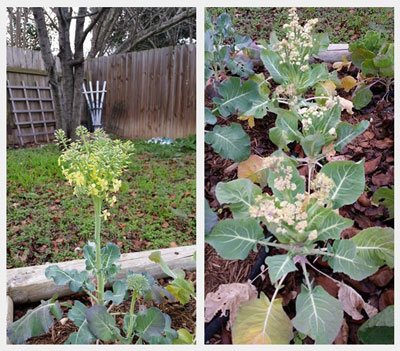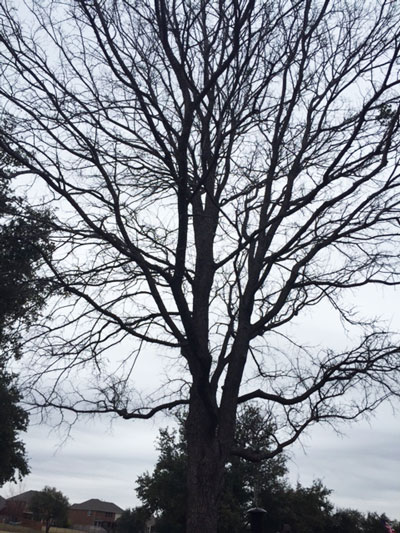Questions and Answers: March 2015
Gardeners are a curious lot, and this section of e-gardens has always been the one with the greatest number of readers. Send Neil your question, but be sure you accompany it with a photograph (required), and please tell him the city in which you’re gardening. Here are his replies to questions that have come in recently.
Question: I’m seeing black spots at the base of my red oak. They started on the east side, but now they are appearing on the north side, and they appear to be damaging the trunk. What should I do? M.R., Rockwall.


Answer: This is a problem I have seen occasionally, but with which I am not able to help with certainty. I contacted Russell Peters of Arborilogical Services in DFW for his input. He has a master’s degree in plant pathology, specializing in oaks, and he also is a former Arborist of the Year for Texas. Here is what he sent back: (Thanks, Russ!)
“This appears to be one of the fungal canker diseases that colonize our shade trees. It looks like possibly Bleeding Canker/ Strumella Canker but an exact identification is unimportant.
The vast majority of these organisms are able to get started due to plant stresses. This tree must have gone through a rough time that allowed this disease to colonize in it. Once the organisms take hold like this, they can be really, really difficult to eliminate. They are most often found along the main trunk, often from the soil line up. The only management for these infections is to try improving the overall health and vigor of tree, so that it can better defend itself.
There also appears to be some borer activity that is resulting in some of the black stained areas. It is common for borers to attack the tissue surrounding trunk cankers because, as stated, this tissue is stressed.”
Question: For the past several years, I have tried to get rid of the grass in the attached photo. Not wanting to use grass killer because it’s in my backyard, I tried pulling and hoeing them out, only to have it come back in full force. What can I do? M.Z., no city given.

Answer: This is the tenacious perennial weed grass called dallisgrass. There are only two ways to get rid of it, and each will disfigure your lawn for a short period of time. One is to dig out each entire clump using a nursery spade. Hoeing or pulling will never get all of the roots out. You’ll want to dig out and remove the entire “cone” of the grass and its root mass, then fill the hole with the same type of soil you have removed. Your bermuda turf will cover the bare ground fairly quickly come April and May, or you can dig squares of the grass from some out-of-the-way place in your landscape and plant them into the voids. (Buying new sod to fill the holes runs the risk of getting a second type of bermuda started in your lawn.)
The other option (the one I would use) would be to spray the area with a glyphosate-only weedkiller (no other active ingredients). You said you don’t want to use weedkillers in your backyard, but this one would be of no worry to me, even with our grandchildren playing in the area. Just give it a couple of hours to dry. I leave that choice up to you. One of our readers had a great idea of how to contain the spray strictly to the clumps of dallisgrass. He suggested cutting the bottom out of a 1-gallon plastic milk jug, then holding the jug down over the clump of dallisgrass. He inserts the nozzle of his tank sprayer into the jug through the top. The plastic walls contain the spray strictly to the weed.
Question: I noticed last summer that my crape myrtle’s trunk and limbs were very white. I thought it had aphids and treated accordingly. In a search of the Internet, I found a Texas A&M post saying this is a new scale insect. My plant had the same symptoms described in the article, including the sooty branches. What more can I do? J.B., no city given.

Answer: This pest has been identified as crape myrtle scale. It is found in China, and was first reported in Texas in Richardson in 2004. It can be very disfiguring, but it is not especially harmful. Research is ongoing, but at this point it appears that an application of Imidacloprid in mid-May followed by a heavy watering is the best means of protecting against the next life cycle of the insect. Here is what we have on the website of The Crape Myrtle Trails of McKinney. http://crapemyrtletrails.org/pest-control/ Scroll down to find Dr. Mike Merchant’s report.
Question: I planted broccoli and cauliflower transplants in September. Both plants grew, but they are flowering. Where did I go wrong? B., New Braunfels.

Answer: Timing is critical in growing these two members of the cabbage family (as it is with growing most types of vegetables in our odd Texas climate). For your part of South Texas, prime planting time for these plants in your spring garden is early to mid-February and for the fall garden late August or early September. Start with vigorous transplants, and plant them into a sunny site with well-prepared garden soil. Fertilize them vigorously and keep them growing actively. Any interruption in their growth will promote the formation of flowers. These plants are not going to be productive for you. You need to remove them and start with new vegetables. Broccoli matures more quickly than cauliflower, so at this late date for your area, you might just try broccoli.
Question: What is this strange growth on my Texas mountain laurel? I’ve taken it to several nurseries, and no one seems to know. I pruned it out, but it has come back. Do I need to be worried about it? P.C., no city given.

Answer: This is fasciated growth. That means that the cells have divided in only two dimensions, resulting in the odd-looking flattened growth. The most common example of this same type of plant behavior is with the annual flower called cockscomb (celosia). I’ve seen it on mountain laurels a number of times, including on one of my own. It’s not anything you want, so merely clip it off by trimming back into normal vegetative growth. Your trimming to date hasn’t removed enough plant tissue, hence its regrowth.
Question: My live oak has lost all of its leaves. It started in the summer with squirrels chewing on the small branches. I’m hoping the tree is not dead. What can I do to help it? S.S., Frisco.

Answer: I really want to help, but I can’t tell much from the silhouette photo of the tree. If it’s this bare, however, it’s highly likely that the top of the tree has been lost. It could be from drought, sunscald, mechanical injury or a variety of other causes. You need to decide if you want to hire a certified arborist to take a look at it. He or she might not be able to save the tree, but at least you should be able to determine what happened to it.
Question: I recently saw ants crawling in and out of these holes in my cedar elm. Should I be concerned? K.R., Aledo.

Answer: No. The holes were caused by sapsuckers or woodpeckers. They don’t suggest any presence of harmful insects, and the birds do minimal harm on their own. You could apply a light coating of black pruning paint to seal the exposed surfaces. The ants may be feeding on sap that is oozing from the holes.
Question: I have 15 evergreens that are about 10 feet tall. Each has a center stalk that is dying. A nursery said it might be cotton root rot. Do you have any suggestion? H.H., no city given.

Answer: This is not cotton root rot. Junipers are immune to that disease, plus it kills entire plants, not one branch at a time. Blue Point and several other junipers have a problem with Phomopsis twig blight. I’ve seen it take entire tops out of large plants, and there isn’t much that can be done to cure it. They can be pruned to remove the dead wood, but it takes the plants a couple of years to grow enough to restore good shape. By then, other branches may be infected. I’ve quit recommending Blue Point for that reason. Oakland hollies have somewhat the same growth habit if they could work for you. I wish I had better news.
Question: One of the trunks of this tree died. I cut it off as you see here. Did I go down far enough, or should I cut it lower? J.K., Fort Worth.

Answer: You need to cut it off farther down so that it can produce bark over the cut surface. If you leave it like this, decay will assuredly set in and probably ruin the entire tree. I’ve tried to illustrate where I would make the cut with a line on your photo. However, if you are still in doubt, a certified arborist would know exactly what to do.
